Tropical soda apple (Solanum viarum Dunal) is a serious weed problem in many perennial grass pastures and native areas of Florida. With foliage unpalatable to livestock, this invasive weed can infest a pasture in as little as one to two years, resulting in reduced forage production and lower stocking rates. This publication is intended for UF/IFAS Extension faculty, state and federal government personnel, and producers who need additional information on the management of this invasive species.
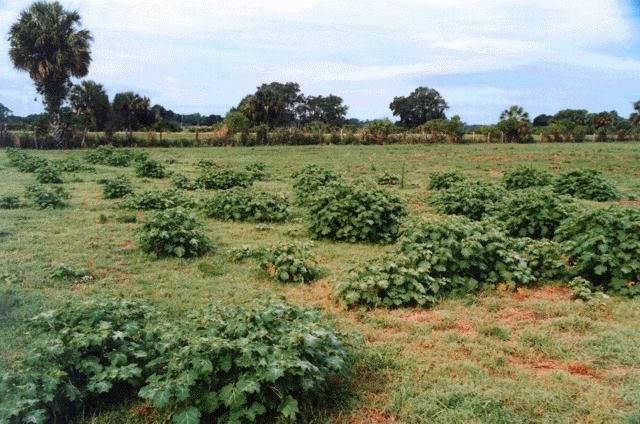
Geographically, the incidence of this weed in Florida has been highest in South Florida, although the plant is now commonly observed throughout the state. Tropical soda apple (TSA) is a common weed in pastures, ditch banks, citrus groves, sugarcane fields, and rangeland. The plant appears to be restricted to semi-disturbed sites. The highest incidence of TSA has occurred in improved pastures, such as bahiagrass, with an estimated 1 million acres infested in Florida.
This invasive weed produces a yellow fruit when mature (1–1.5 inches in diameter), which contains 200–400 seeds per fruit. Little or no seed dormancy has been observed, and germination is generally greater than 75%. The plant is readily identified by its immature fruit, which are green with white mottling, similar to watermelon. Fruit production occurs throughout the year, but mostly from September through May, providing 40,000–50,000 viable seeds per plant per year. Wildlife, such as feral hogs, raccoons, and deer, feed on the fruit and are vectors for spreading seed through their feces. Cattle will also consume the fruit and spread the seed in this way.
Weed Taxonomy
At maturity, TSA is 3–6 feet tall and can be as wide as it is tall. Stems, leaves, flower stalks and calyxes have broad-based, white to yellowing thorns up to 0.4 inches long. Pubescent leaves are 4–7 inches long and 2–6 inches wide, deeply divided into broad, pointed lobes. Flowers are white with yellow stamens, a few together on stems below the leaves. Fruits are glabrous, globular, about 1 inch in diameter, and yellow when mature. Seeds are light red-brown, and 0.10 inches in diameter. Seeds are only moderately flattened, contained in a mucilaginous layer that contains a glyco-alkaloid called solasodine.
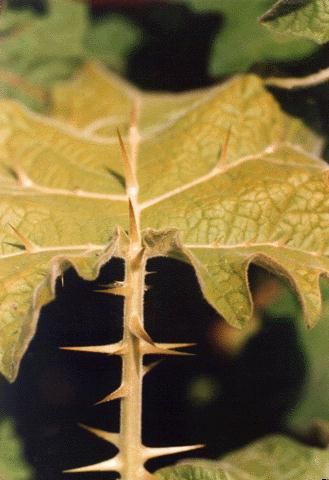
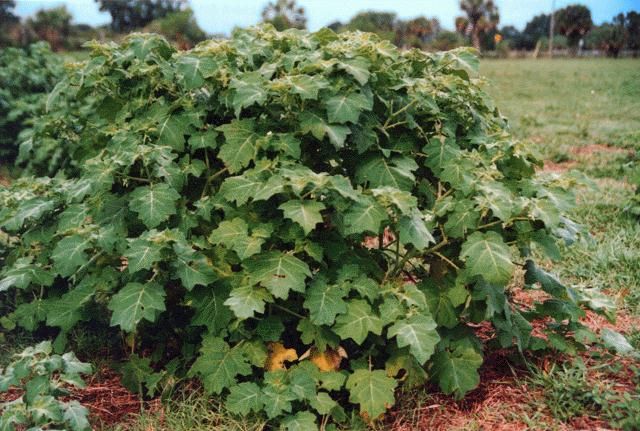
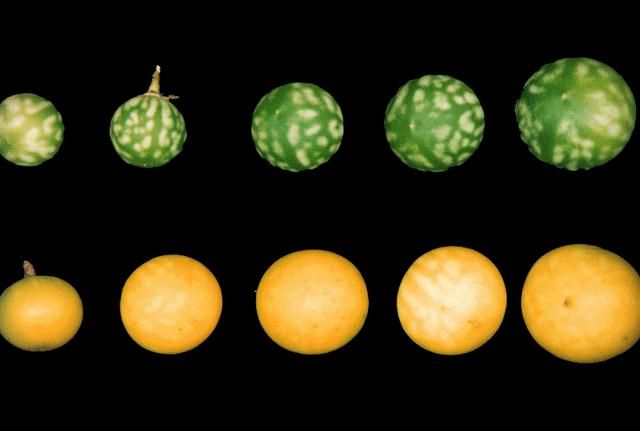
Weed Biology
Tropical soda apple flowers throughout the year, but flowering is concentrated from September through May. Fruit production is also yearly, and a mature plant will commonly have both immature fruit (green) and mature fruit (yellow). Seed germination from green fruit is often similar to that of yellow fruit. Regardless of fruit color, if seed is white in color, it is not viable.
Seedling emergence primarily occurs during the dry season (October through May). New plants will emerge either from seed or perennial roots. Roots have buds that regenerate new shoots. The root system can be extensive, with feeder roots (0.25–1.0 inch in diameter) located a few inches below the ground and extending 3–6 feet from the crown of the plant.
Seed germination has occurred from seed planted 3.25 inches into the ground. It is not known how deep TSA seed may be placed in the soil before germination is inhibited. However, preliminary evidence suggests that seeds of this plant buried 6 inches deep will not germinate until they are brought back to the soil surface. Seed germination depends on temperature, light, and age of seed. Under laboratory conditions, seed germination was highest (95%) for 5-month-old seed, followed by a gradual decline to zero germination at 25 months. Under field conditions, preliminary evidence suggests that buried seed may survive longer than seed left on the soil surface.
Weed Ecology
Tropical soda apple is a common weed in South America, India, the West Indies, Honduras, and Mexico. The plant is native to Argentina and central Brazil and has been introduced in Africa and Nepal. Tropical soda apple can be expected to occur in other subtropical areas as well.
In Florida, TSA has been observed as a common weed in pastures, ditch banks, citrus groves, sugarcane fields, and wet areas of rangeland. In South Florida, TSA is typically found on seasonally wet soils. During extended periods (more than three weeks) of standing water, TSA plant death can occur. In ideal conditions, TSA was once commonly found growing as a monoculture covering up to 50 acres or more. Currently, monocultures of 50 acres or more are typically rare, but TSA monocultures are common in feeding and lounging areas within pastures.
Solanum sp. was first reported by ranchers in South Florida in the early 1960s. However, these initial reports indicated the fruit was a cherry-red color, not yellow. Apparently, ranchers were observing Solanum capsicoides (Figure 5), not TSA. For the past 15–20 years in South Florida, TSA has been the most prevalent of those two species.
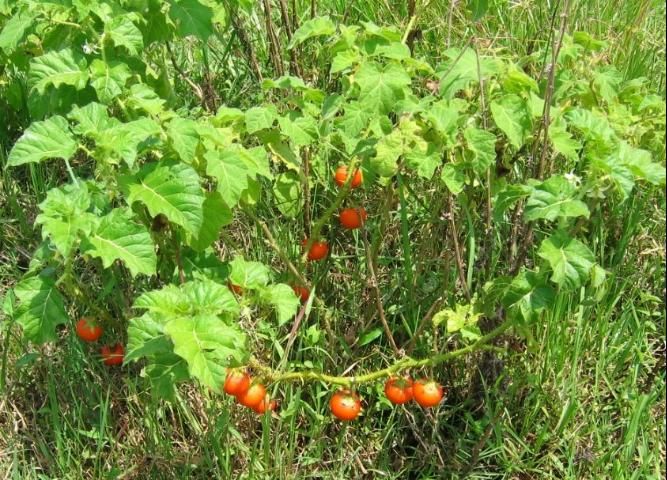
Reasons for the increase in TSA are not well understood. Although cases were reported of severe leaf defoliation of TSA caused by Colorado potato beetle, as well as the released biocontrol agent Gratiana boliviana (commonly referred to as the TSA beetle), death of TSA plants due to defoliation is rare. Occasionally, TSA plants appear stressed and display symptoms of leaf mottling, inclusions, etc., associated with fungi or bacteria.
Chemical Control
Dense Infestations
Aminopyralid-containing herbicides (Milestone, GrazonNext HL, Chaparral, and DuraCor) are the most effective for controlling dense stands of TSA. These herbicides possess postemergence control of existing plants and preemergence control of germinating seeds. Our research has shown that these herbicides will control germinating seedlings for at least six months after application.
The application rates for these herbicides are: Milestone at 5–7 oz/A, G GrazonNext HL at 1.5–2.1 pt/A, Chaparral at 3.0 to 3.3 oz/A, and DuraCor at 16 to 20 oz/A. Although the lower application rates are highly effective on existing TSA plants, the higher rates suggested for these two herbicides will provide more soil activity and are suggested if large amounts of TSA seed are present in the soil. Although mowing prior to herbicide application is not required, it is important to add a non-ionic surfactant (0.25% v/v) and apply the herbicide solution in at least 20 gallons of water per acre. The proper choice of these herbicides is dependent upon the desirable forage in the pasture or hayfield.
Another option is to use triclopyr (Remedy Ultra, others). When using triclopyr, mow plants to a 3-inch stubble height as soon as possible to keep plants from producing fruit and seed. Repeat mowing when plants reach the flowering stage (50–60 days) through April. Fifty to 60 days after the April mowing, when plant regrowth is at the first flower stage (late May-June), spray triclopyr at 1 qt/A + 0.25% v/v non-ionic surfactant in 40 gal/A of water. Triclopyr does not possess soil residual activity, and follow-up applications to control escaped or new seedlings will be necessary.
Regardless which herbicide is used, regular scouting after treatment is necessary. Tropical soda apple can produce fruit at almost any time during the growing season and give rise to hundreds of additional plants. It is important to monitor the fields to ensure that no plants are allowed to reestablish and produce fruit.
Sparse Infestations
Areas with low TSA infestation should be targeted, and each plant sprayed individually. Recommended herbicides for 95%–100% control are as follows:
- Milestone at 0.5–0.8 oz per 2.5 gal (15–20 ml per 2.5 gal) + 0.25% v/v non-ionic surfactant + color marker. (Use a color marker with the herbicide solution to avoid spraying the same plant twice or not spraying a plant at all).
- GrazonNext HL or triclopyr at 0.5 to 1% solution (50 to 100 ml per 2.5 gal) + 0.25% non-ionic surfactant + color marker.
- DuraCor at 0.13 to 0.63% solution (0.5 to 2.4 fl oz per 3 gal) + 1% methylated seed oil (MSO) + color marker. Use the lower amount when using high-volume foliar applications.
When spot-spraying, cover the entire plant with spray solution to ensure herbicide uptake and maximum control. Allow herbicides to dry on plants three to four hours before rainfall. Monitor treated areas monthly, and treat new TSA seedlings. Do not allow plants to produce fruit. Be sure to follow the guidelines for spraying volatile herbicides such as triclopyr. (For more information, see EDIS publication SS-AGR-12, Florida's Organo-Auxin Herbicide Rule - 2012, https://edis.ifas.ufl.edu/publication/wg051.)
Biological Control
Biological Herbicide
A natural, biological herbicide to control TSA is currently under development and is not available for public use at this time. The product is called SolviNix™ and contains a naturally occurring virus called Tobacco mild green mosaic tobamovirus (TMGMV). Preliminary research has determined that very small quantities of the virus (2 g of active ingredient per acre) provide excellent control of TSA. Two application methods are currently being tested that appear to be practical and user-friendly for both boom spraying and spot-spraying. For additional information on Solvinix, including label and contact information, see the BioProdex, Inc. website: http://bioprodex.com/products/.
TSA Beetle
A beetle known as Gratiana boliviana (TSA beetle) has been investigated over the past several years for control of TSA plants. This beetle is native to South America and underwent a rigorous quarantine process prior to its release in 2003. Host-specificity tests were conducted in both the United States and South America; the tests proved that this beetle is highly specific to TSA. From 2003–2011, over 250,000 beetles were released throughout Florida and populations are considered established. For more detailed information on the TSA beetle, see EDIS publication ENY-865 Classical Biological Control of Tropical Soda Apple with Gratiana boliviana (https://edis.ifas.ufl.edu/in971).
Unless present at very high populations, the TSA beetle does not control individual plants. However, this beetle reduces the overall fitness of the plant, making the plant less competitive with other plants. The beetle also reduces the number of fruit formed by the TSA plant. Therefore, the beetle would not be suited for controlling large populations of TSA, but is appropriate for small infestations or where TSA is present in remote areas. Whether TSA stands treated with the beetle are sparse or dense, it is likely the TSA will rebound during the winter months (particularly during winters with no hard freezes). The TSA beetle goes through a period of diapause during winter months and will not feed on leaf tissue or reproduce during that period. Monitor the effectiveness of these beetles as they have many natural enemies. Currently, TSA beetles are no longer being reared for additional releases.
Management to Prevent the Spread of TSA
Because populations of TSA continue to increase in the southeastern United States, it is imperative to continue to prevent the spread of TSA within and across the Florida border. Although the movement of TSA seed by wildlife cannot be prevented, movement of this seed can be limited in some ways. One way to prevent the movement of TSA seed is to clean all equipment when leaving a pasture or area infested with TSA. Be sure to clean vehicles, mowers, tractors, and shoes.
Cattle can also transport TSA seeds. Therefore, it is important to ship cattle from an area that does not have TSA or is TSA fruit free. Mowing a TSA-infested pasture prior to shipping will eliminate the fruit and the consumption of TSA seed by the cattle. The TSA seed can remain viable in the digestive tract for up to six days. Therefore, when you buy cattle, hold them in one area for up to six days to avoid the spread of TSA to other areas on your ranch.
Further Information
Sellers, B.A. and J.A. Ferrell. 2013. Tank-Mix Options for Control of Tropical Soda Apple and Dogfennel. SS-AGR-300. Gainesville, FL: University of Florida Institute of Food and Agricultural Sciences. https://edis.ifas.ufl.edu/publication/ag306
Tropical Soda Apple Best Management Practices:
TAME Tropical Soda Apple: https://pesticide.ifas.ufl.edu/TropicalSodaApple/index.shtml
Publication History
Since its original publication in print format in 1993, this fact sheet has undergone many revisions by various authors. The following previous versions are available in the UF Digital Library
Mullahey, J. Jeffrey and Daniel L. Colvin. 1998. Tropical Soda Apple: A New Noxious Weed in Florida. WEC-7. [UFDC]
Mullahey, J. Jeffrey. 2003. Tropical Soda Apple: A New Noxious Weed in Florida. WEC-7. [UFDC]
Mullahey, J. Jeffrey, Jason Ferrell, and Brent Sellers. 2006. Tropical Soda Apple: A Noxious Weed in Florida. SS-AGR-77. [UFDC]
Sellers, Brent, Jay Ferrell, J. Jeffrey Mullahey, and Pat Hogue. 2009. Tropical Soda Apple: Biology, Ecology and Management of a Noxious Weed in Florida. SS-AGR-77. [UFDC]
Starting with the 2009 revision, this publication also supercedes the following publications, which are available in the UF Digital Library:
- SS-AGR-50 (WG201) Tropical Soda Apple (Solanum viarum Dunal) in Florida / J. A. Ferrell and J. J. Mullahey [UFDC]
- SS-AGR-78 (UW187) Shipping Cattle, Not Tropical Soda Apple Seed / Jeff Mullahey, Pat Hogue, Jason Ferrell, and Brent Sellers [UFDC]
- SS-AGR-129 (AG261) Tropical Soda Apple Control: Sorting Through the Options / J. A. Ferrell, B. Sellers, and J. J. Mullahey [UFDC]
- SS-AGR-130 (UW188) Management Practices to Control Tropical Soda Apple / Jeff Mullahey, Pat Hogue, Jason Ferrell, and Brent Sellers [UFDC]
- SS-AGR-131 (UW189) Tropical Soda Apple Making a Comeback / Pat Hogue, Jeff Mullahey, Jason Ferrell, and Brent Sellers [UFDC]